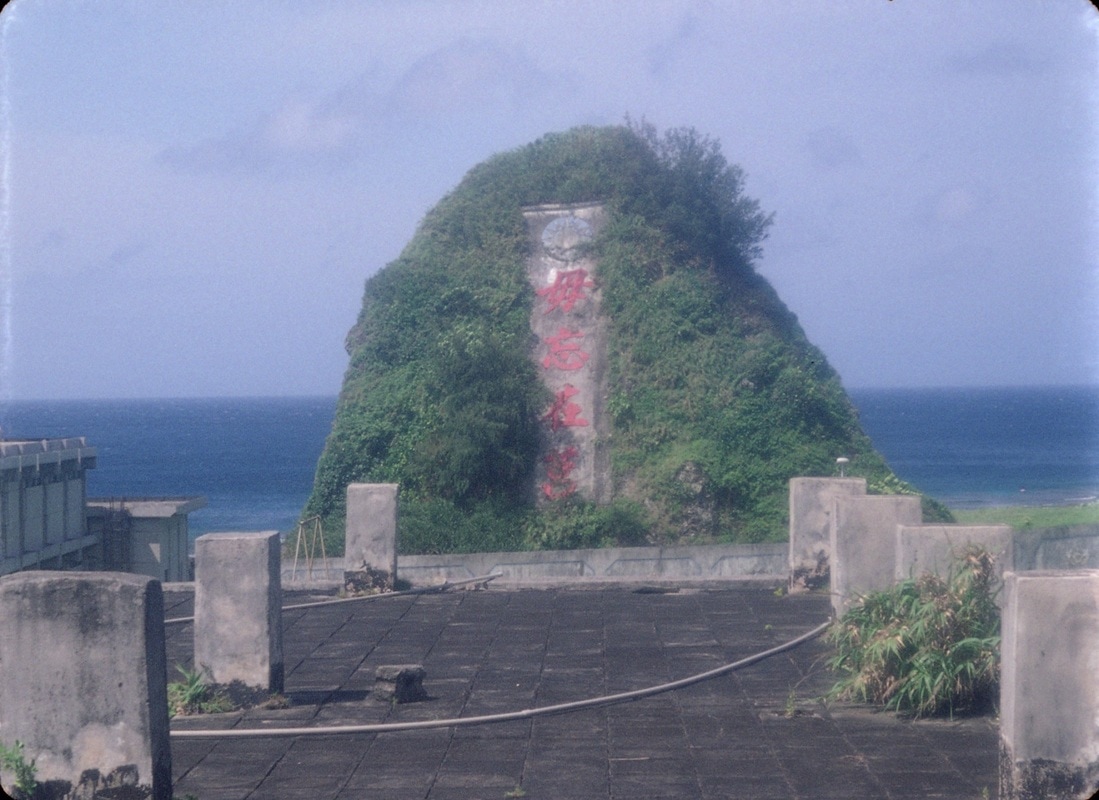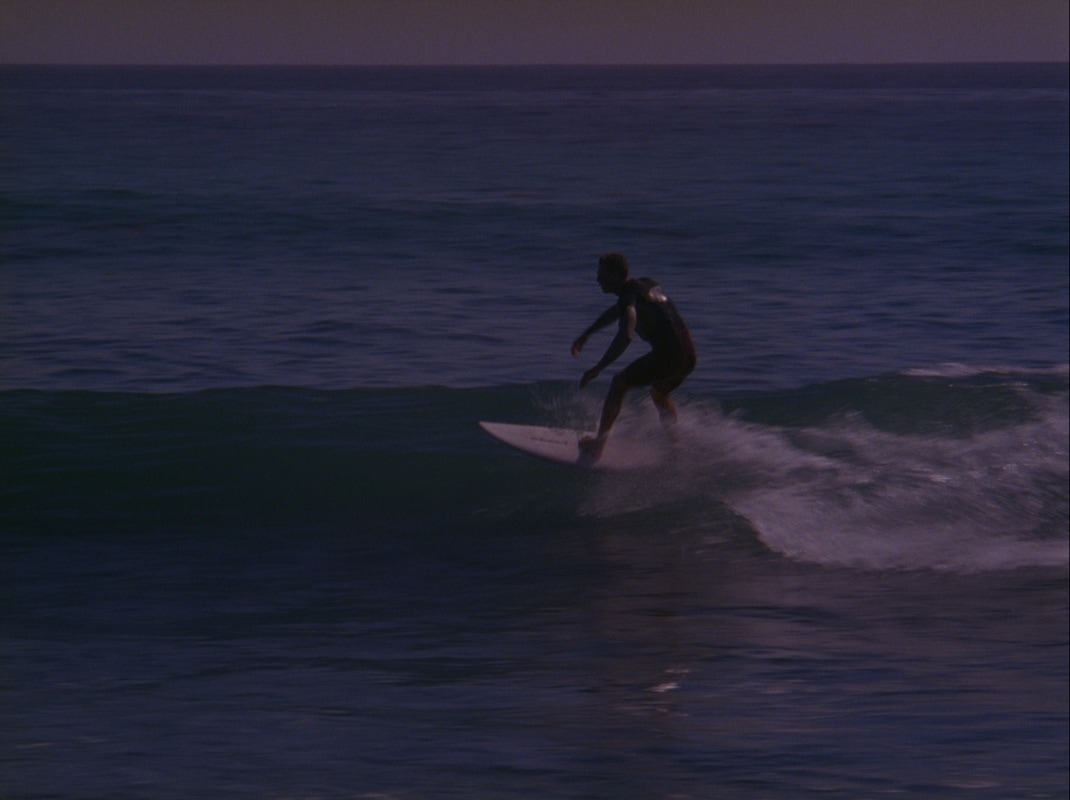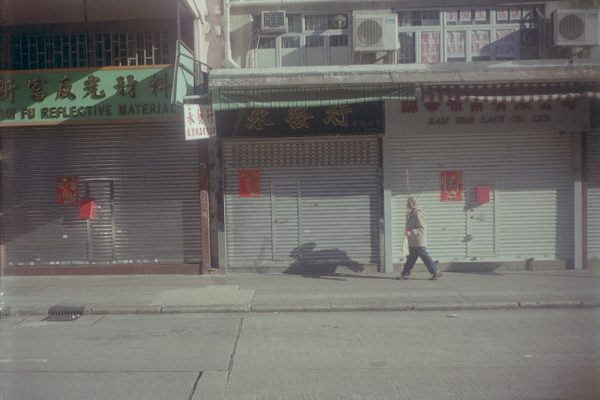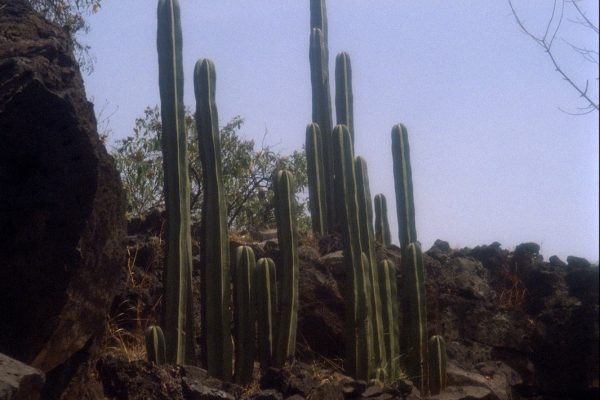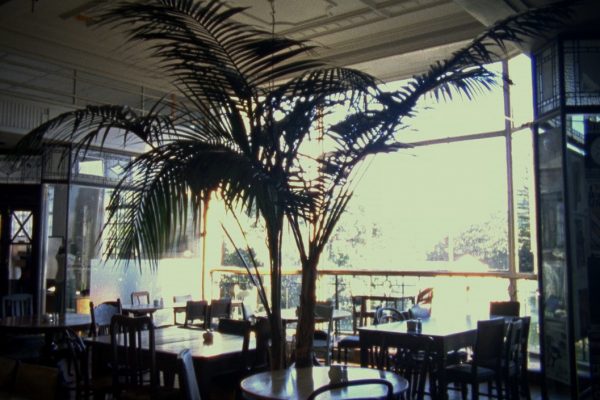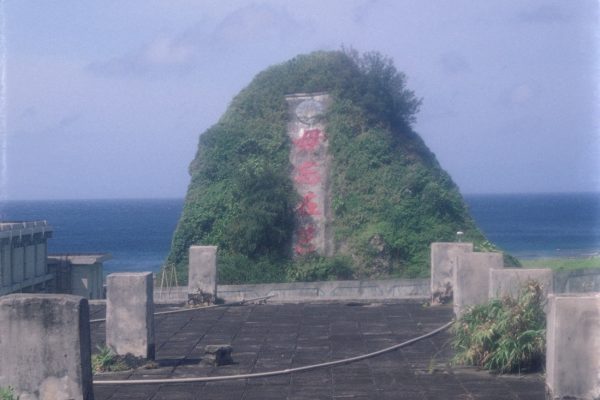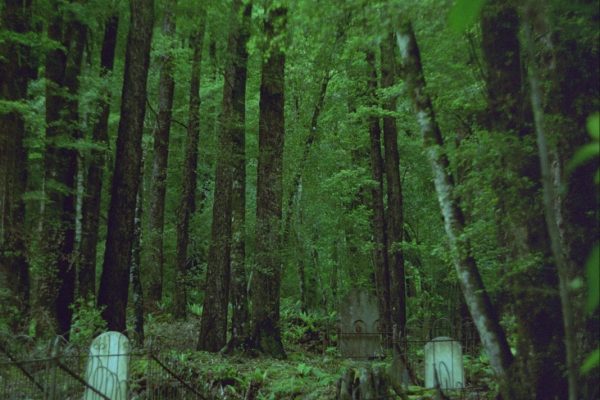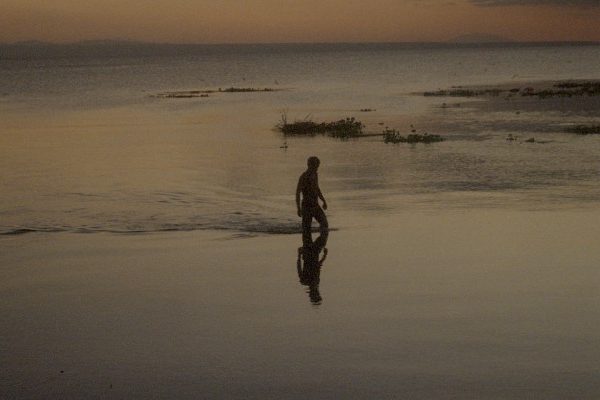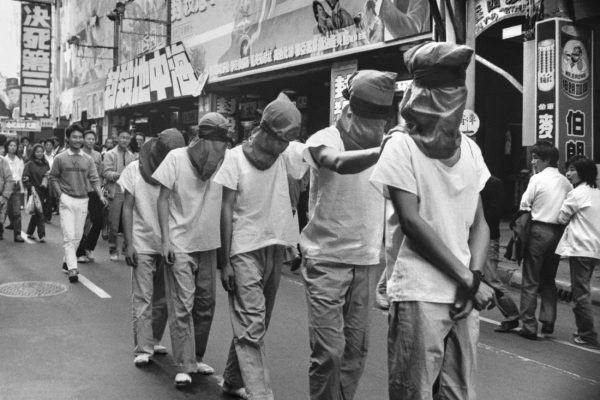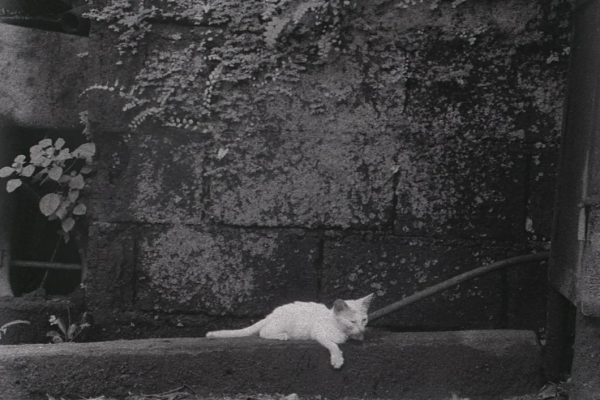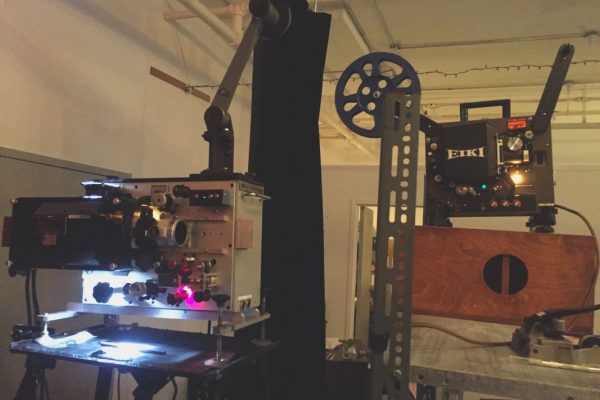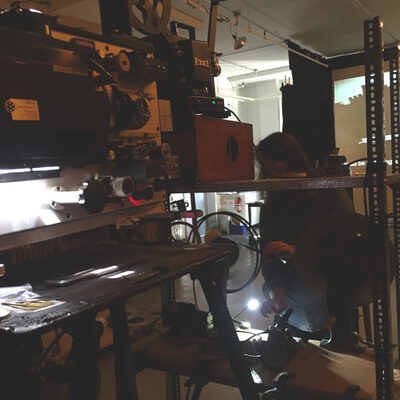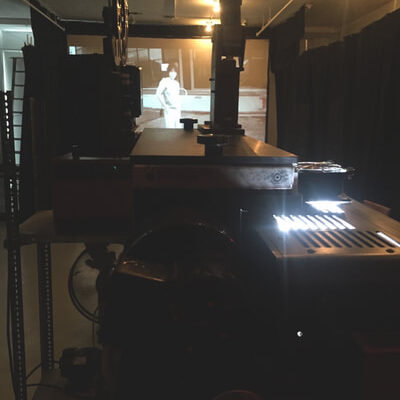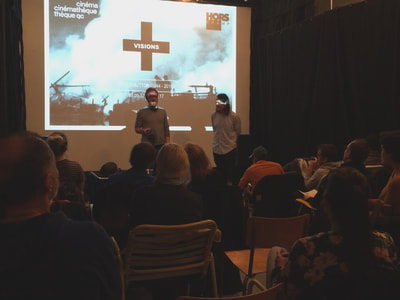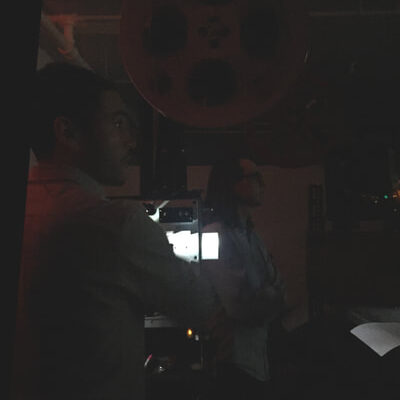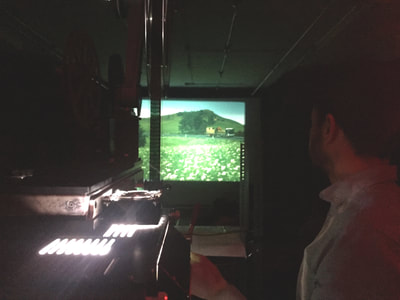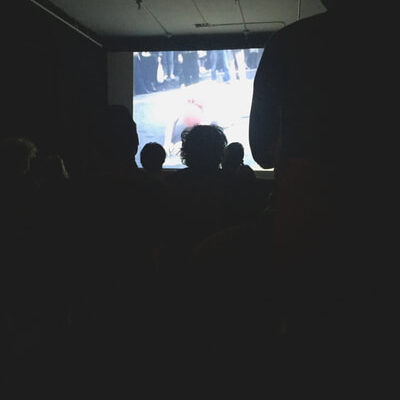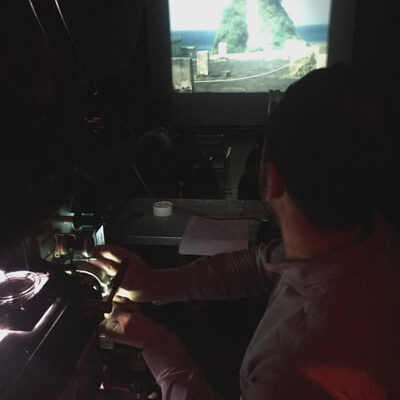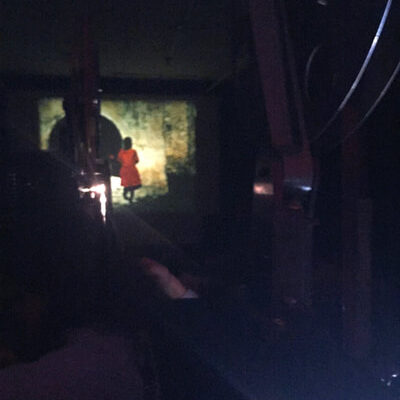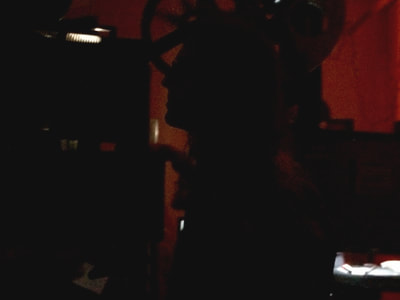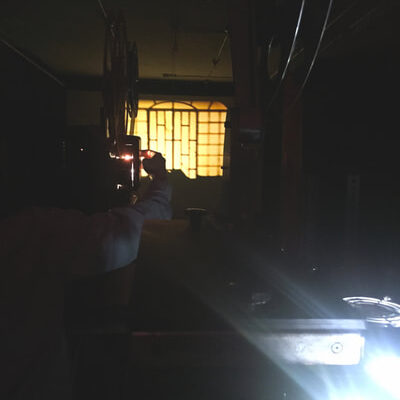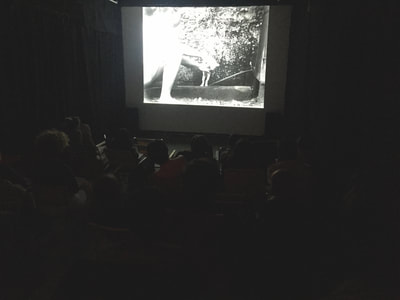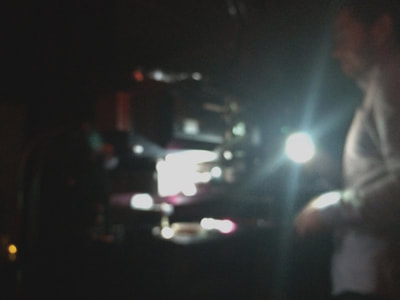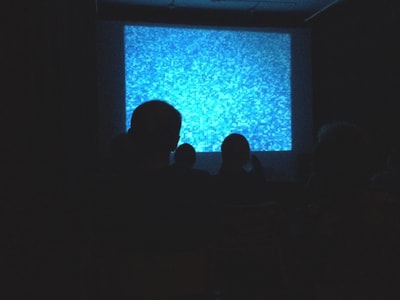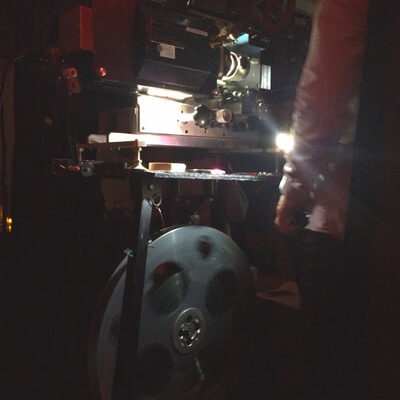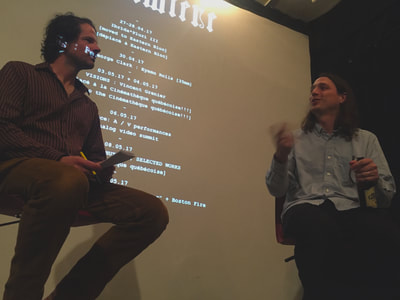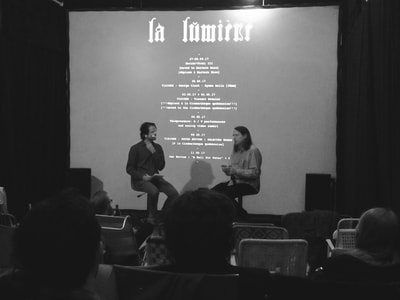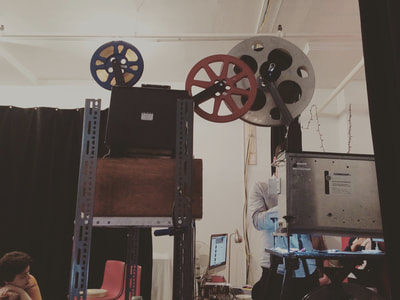“More and more, my memory and experience of films is coloured by the places in which or the people with whom I encountered them. This screening brings together works that have been important to me over the last few years selected from places where I have lived for a time and where I have filmed.” – George Clark
Ses projets de commissariat et ses écrits portent sur l’évolution de l’histoire des pratiques filmiques et vidéos, globalement. Pendant son temps au Tate Modern (2013-2015) et au fil de ses projets indépendants, il s’est intéressé davantage à l’histoire du cinéma élargi, du film ethnographique, a programmé les rétrospectives de Ute Aurand, Julian Dashper, Lav Diaz, Camille Henrot, Luis Ospina, Chick Strand et a réalisé divers projets thématiques tel que Throwing Shadows: Japanese Expanded Cinema in the Time of Pop (Tate Modern, 2016 avec Go Hirasawa et Julian Ross), L.A. Rebellion: Creating a New Black Cinema (Tate Modern, 2015) et Infermental (Focal Point Gallery, 2010 avec Dan Kidner et James Richards).
GEORGE CLARK
George Clark est un artiste et commissaire d’origine britannique. Ses œuvres récentes : une exposition solo A Planter’s Art, qui consistait en la présentation de films et une installation dans un jardin au Soulangh Cultural Park (Tainan, juin-juillet 2016), un long-métrage intitulé A Distant Echo (Images Festival, 2017) et un court-métrage Sea of Clouds / 雲海 (2016) réalisé à Taïwan et structuré autour d’une entrevue avec l’artiste Chieh-jen. Précédant ces réalisations, Clark a collaboré auprès de divers artistes dont Luke Fowler et Beatrice Gibson. Ses projets de commissariat et ses écrits portent sur l’évolution de l’histoire des pratiques filmiques et vidéos, globalement. Pendant son temps au Tate Modern (2013-2015) et au fil de ses projets indépendants, il s’est intéressé davantage à l’histoire du cinéma élargi, du film ethnographique, a programmé les rétrospectives de Ute Aurand, Julian Dashper, Lav Diaz, Camille Henrot, Luis Ospina, Chick Strand et a réalisé divers projets thématiques tel que Throwing Shadows: Japanese Expanded Cinema in the Time of Pop (Tate Modern, 2016 avec Go Hirasawa et Julian Ross), L.A. Rebellion: Creating a New Black Cinema (Tate Modern, 2015) et Infermental (Focal Point Gallery, 2010 avec Dan Kidner et James Richards).
George Clark is an artist and curator from the UK. Recent work includes the solo exhibition A Planter’s Art that featured film works and a garden installation at Soulangh Cultural Park, Tainan, June-July 2016, the feature film A Distant Echo (showing at Images Festival 2017) and his short film Sea of Clouds / 雲海 (2016) made in Taiwan and structured around interviews with the artist Chen Chieh-jen. Prior to this work he collaborated with various artists including Luke Fowler and Beatrice Gibson. His curatorial projects and writing have focused on expanding histories of film and video practice globally. Through his work at Tate Modern (2013-2015) and on independent projects, he has explored histories of expanded cinema, ethnographic film and curated retrospectives of Ute Aurand, Julian Dashper, Lav Diaz, Camille Henrot, Luis Ospina, Chick Strand as well as thematic projects including Throwing Shadows: Japanese Expanded Cinema in the Time of Pop (Tate Modern, 2016 with Go Hirasawa and Julian Ross), L.A. Rebellion: Creating a New Black Cinema (Tate Modern, 2015) and Infermental (Focal Point Gallery, 2010 with Dan Kidner and James Richards) among others.
UNTITLED (EYEMO ROLLS #1 – #128)
Aotearoa New Zealand, Hong Kong, Mexico, Philippines, Taiwan, Thailand, USA | 35mm | Colour | Silent | 2011 – ongoing.
20h00 | 75 min
« C’est oblique, mais tout y est. » – [George Clark, Untitled (Eyemo rolls), 2011-2017]
« Le plus que je puisse faire, c’est d’essayer de répéter ce qu’il s’est passé dans une autre zone, mentalement parlant, essayer de distinguer ce qui soudainement fait partie de ce conglomérat et quelles autres associations s’y sont intégrées de manière parasitaire ». – [Julio Cortazar, 62: A Model Kit]
Plus le temps passe, plus ma mémoire et mon expérience des films sont colorées par des lieux et des personnes avec qui je les ai vus. Ce programme rassemble des œuvres qui m’ont marqué au cours des dernières années, des oeuvres qui proviennent d’endroits où j’ai vécu un certain temps, où j’ai filmé. Le programme présente des oeuvres issues de divers pays, ponctué par des fragments de mon propre projet en cours intitulé Untitled (Eyemo rolls), réalisé dans ces mêmes pays depuis que j’ai commencé à voyager avec une caméra Eyemo 35mm en 2011. Chaque film s’inspire d’une géographie particulière, mais brouille également les lignes géographiques. Le projet est un moyen de penser l’enchevêtrement – le cinéma en tant qu’espace liant des lieux.
Les films sélectionnés portent sur des lieux précis, et présentent tout à la fois leur mémoire propre, des sous-cultures qui se ré-approprient l’espace, et la résistance à l’occupation. Les œuvres sont issues de chacun de ces lieux, tout en flouant leur limite. L’artiste thaïlandais Apichatpong Weerasethakul a réalisé 0116643225059 alors qu’il se languissait de son pays natal lorsqu’il étudiait à Chicago. Chick Strand a réalisé Guacamole au Mexique au fil de ses voyages périodiques à destination de ce pays à départ de chez elle, Los Angeles. L’iconoclaste Letter to the Young Intellectuals of Hong Kong de Mok Chiu-yu, un appel à l’action politique à Hong Kong pendant la colonisation britannique. The Garden of M.B. de Louise Menzies retraçant le déplacement des palmiers Kentia, et 機能喪失第三號 / Dysfunction No.3 de Chieh-Jen, dénonçant les conditions de vie en Taïwan à l’époque où la loi martiale régnait. Un équilibre délicat existe dans ses œuvres entre la perspective des observateurs et les mises-en-scène exécutées devant la caméra, qui se cristallisent dans Director’s Cat du collectif Tito & Tita ainsi que dans l’expérimentation sonore et visuelle de Laida Lertxundi avec son ode californienne My Tears Are Dry.
Untitled (Eyemo rolls) est un film qui existe en dialogue avec d’autres œuvres, dans les interstices qui existent entre d’autres films. Le projet est issu d’une série de bobines de 100 pieds que je filme depuis 2011 dans différents pays à l’aide d’une caméra Eyemo 35mm Bell & Howell, en réponse à mes rencontres et aux œuvres que j’ai vues dans ces lieux. L’écrivain Julio Cortazar, qui a écrit la majorité de ses livres en exil à Paris, questionne les frontières des espaces : une influence cruciale pour ce projet. Dans une entrevue à propos de son roman Marelle (qui invite le lecteur à lire les chapitres dans l’ordre qu’il désire), Cortazar déclare que « le livre ne propose aucune solution ; il se limite simplement à montrer les chemins possibles qui peuvent être empruntés par le lecteur afin d’abattre le mur pour voir ce qui se trouve de l’autre côté. »
“It’s oblique but it’s all there.” - [George Clark, Untitled (Eyemo rolls), 2011-2017]
“The most I can do is try to repeat what took place in a different zone in mental terms, trying to distinguish between what made up a part of that sudden conglomeration in its own right and what other associations might have become incorporated into it parasitically.” - [Julio Cortazar, 62: A Model Kit]
More and more, my memory and experience of films is coloured by the places in which or the people with whom I encountered them. This screening brings together works that have been important to me over the last few years selected from places where I have lived for a time and where I have filmed. The programme features works from Thailand, Hong Kong, Los Angeles, Mexico, Taiwan, the Philippines and Aotearoa New Zealand, interspersed with fragments from my ongoing project Untitled (Eyemo rolls) shot in these various countries since I began travelling with a Eyemo 35mm film camera in 2011. Each work is drawn from a particular geography but also blurs the lines between them. The project is a way to think about entanglement, of the cinema as a locality between places.
The selected films speak to particular places but also to the memory of them – to subculture’s reclaiming of space or the resistance against occupation. The works are drawn from each of these locations but often they blur the line between them: Thai artist Apichatpong Weerasethakul’s 0116643225059 was made while he was homesick while studying in Chicago; Chick Strand’s Guacamole was made in Mexico during her periodic trips there from her home in Los Angeles. Mok Chiu-yu’s iconoclastic Letter to the Young Intellectuals of Hong Kong is an open call to political action in Hong Kong during British colonial rule and Louise Menzies’ The Garden of M.B. is about the displacement of the Kentia Palm and Chen Chieh-Jen’s work is an action against the conditions in Taiwan during period of martial law. A careful balance exists in many of the works between the observers’ perspective and staged scenarios in front of the camera: from the collective Tito & Tita’s feline screen-test Director’s Cat to Laida Lertxundi’s sound-image experiments in her Californian ode My Tears Are Dry.
Untitled (Eyemo rolls) is a film that exists in dialogue with other works in the gaps between other films. The project is built from a growing series of 100ft camera rolls that I have been filming since 2011 when I began travelling with a Bell & Howell Eyemo 35mm film camera shooting in different countries as way to respond to people I’ve met and works I’ve seen in these places. The writer Julio Cortazar, who wrote the majority of his work in exile in Paris, explored the blurred boundary between places, has been crucial influence for this project. In an interview about Hopscotch, in which the reader is free to read chapters in any order they choose, Cortazar stated that ‘the book doesn’t propose any solution; it simply limits itself to showing the possible paths one can take to knock down the wall, to see what’s on the other side.’
- EYEMO ROLLS (#1-3)
- 011-66-43-225-059
- EYEMO ROLLS (#26-27)
- THE GARDEN OF M.B.
- THE GARDEN OF M.B.
- EYEMO ROLLS (#120-121, #124)
- DYSFUNCTION NO.3
- EYEMO ROLLS (#87-92)
- LETTER TO THE YOUNG INTELLECTUALS OF HONG KONG | 莫昭如 - 給香港的文藝青年
- EYEMO ROLLS (#74-76)
- MY TEARS ARE DRY
- EYEMO ROLLS (#33-34)
- GUACAMOLE
- EYEMO ROLLS (#57-60)
- DIRECTOR'S CAT
- DIRECTOR'S CAT
- EYEMO ROLLS (#81-84)
George Clark | 35mm | silent | 3 min
Apichatpong Weerasethakul | Thailand | 1994 | 16mm to digital | 5 min
“This film was made early in 1994. I called home less and less and somehow felt it was like a duty to do so. One day, after I had just moved to a new apartment, I realized how aged my mother sounded on the phone. Her childhood black and white photo and the telephone were all I could relate to her here.” - [Apichatpong Weerasethakul]
George Clark | 35mm | silent | 3 min
Louise Menzies| Aotearoa New Zealand | 2013 |digital | 3 min
Dans ce film, des palmiers en pot font partie d’un décor intérieur classique, et agissent tel des balises en délimitant l’espace architectural de l’arcade qui permettent de réaliser une variété de prises de vue. Ces images font directement référence à la documentation de Marcel Broodthaers pour ses installations Décors: Un Jardin d’Hiver. Réalisées entre 1974 et 1975 dans le cadre d’expositions en Europe et en Amérique, la série Décors présentait des éléments propres à l’esthétique des jardins intérieurs européens au tournant du 20ème siècle. Celles-ci faisaient écho aux histoires troublantes de la colonisation rappelant le passé du pays d’origine de Broodthaers, la Belgique. Broodthaears traitait ainsi, à sa façon, de cette notion de “conquête de l’espace”. Dans un décor local, le palmier Kentia, tel que représenté dans le film – présent dans l’arcade, et utilisé par Broodthaers dans ses installations – est rapproché de ses origines afin de nous permettre de repenser notre rapport au temps et à l’espace. Originaire de l’île volcanique Lord Howe, à la forme irrégulière de croissant et vestige de la mer Tasman, le Kentia pousse sauvagement dans le Pacifique du Sud. - [Louize Menzies, Moving Towards the Sun, House Studies II]
In this film, potted palms are pictured as conventional interior decor, and feature as markers for a series of camera positions that map the architectural space of the arcade. These images allude directly to the documentation of Marcel Broodthaers’ late installations Décors: Un Jardin d’Hiver. Made between 1974-75 for exhibitions in Europe and America, the Décors series modelled elements of European indoor garden design from the turn of the twentieth century, recalling uncomfortable colonial histories within Broodthaers’ native Belgium’s past and dealing with, in his own terms, the “conquest of space”. In a local setting, the Kentia palm as pictured in this film — present in the arcade, and the species of palm used in Broodthaers’ works — is brought into closer proximity to its origins, reinterpreting our sense of time and place. Native to Lord Howe Island, an irregularly crescent-shaped volcanic remnant in the Tasman Sea, the Kentia grows unbridled throughout the South Pacific. - [Louize Menzies, Moving Towards the Sun, House Studies II]
Louise Menzies| Aotearoa New Zealand | 2013 |digital | 3 min
Dans ce film, des palmiers en pot font partie d’un décor intérieur classique, et agissent tel des balises en délimitant l’espace architectural de l’arcade qui permettent de réaliser une variété de prises de vue. Ces images font directement référence à la documentation de Marcel Broodthaers pour ses installations Décors: Un Jardin d’Hiver. Réalisées entre 1974 et 1975 dans le cadre d’expositions en Europe et en Amérique, la série Décors présentait des éléments propres à l’esthétique des jardins intérieurs européens au tournant du 20ème siècle. Celles-ci faisaient écho aux histoires troublantes de la colonisation rappelant le passé du pays d’origine de Broodthaers, la Belgique. Broodthaears traitait ainsi, à sa façon, de cette notion de “conquête de l’espace”. Dans un décor local, le palmier Kentia, tel que représenté dans le film – présent dans l’arcade, et utilisé par Broodthaers dans ses installations – est rapproché de ses origines afin de nous permettre de repenser notre rapport au temps et à l’espace. Originaire de l’île volcanique Lord Howe, à la forme irrégulière de croissant et vestige de la mer Tasman, le Kentia pousse sauvagement dans le Pacifique du Sud. - [Louize Menzies, Moving Towards the Sun, House Studies II]
In this film, potted palms are pictured as conventional interior decor, and feature as markers for a series of camera positions that map the architectural space of the arcade. These images allude directly to the documentation of Marcel Broodthaers’ late installations Décors: Un Jardin d’Hiver. Made between 1974-75 for exhibitions in Europe and America, the Décors series modelled elements of European indoor garden design from the turn of the twentieth century, recalling uncomfortable colonial histories within Broodthaers’ native Belgium’s past and dealing with, in his own terms, the “conquest of space”. In a local setting, the Kentia palm as pictured in this film — present in the arcade, and the species of palm used in Broodthaers’ works — is brought into closer proximity to its origins, reinterpreting our sense of time and place. Native to Lord Howe Island, an irregularly crescent-shaped volcanic remnant in the Tasman Sea, the Kentia grows unbridled throughout the South Pacific. - [Louize Menzies, Moving Towards the Sun, House Studies II]
George Clark | 35mm | silent | 3 min
La loi martiale à Taïwan comprenait des lois qui, clairement, éliminaient le droit au rassemblement, aux démonstrations publiques et à la création d’organisations. Malgré tout, pendant un après-midi de vacances en 1983, cinq jeunes personnes sont apparues sur la rue Ximending, habillées de kakis blancs, la tête couverte par des sacs de coton. Ils ont marché, côte à côte, de la Maison Rouge jusqu’au théâtre Wannian, attirant l’attention d’une foule grandissante de passants curieux et alertant les centrales de police ainsi que les policiers en civil. Quand ils sont arrivés à destination, ils ont immédiatement commencé à hurler et crier comme s’ils étaient touchés d’une douleur incommensurable, excepté un des hommes, qui, discrètement, c’est allongé au sol. Cet homme était Chen Chieh-jen. Il avait 23 ans, et il venait de finir son service militaire obligatoire. Il avait planifié cette démonstration qu’il avait intitulé 機能喪 失第三號 / Dysfunction No.3. - [Fang-Tze Hsu, ‘Chen Chieh-jen: Praxis in the Hobbesian Dream, LEAP, 10 May 2013]
Ce rare film est un des seuls documents rescapé représentant une action dissidente de cette époque à Taïwan. Documentant une intervention publique qui a eu lieu le 30 octobre dans le quartier piétonnier commerçant, où se trouve le théâtre, au centre de Taipei.
“Taiwan’s Martial Law provisions included laws clearly suppressing assembly, demonstrations, and the forming of organizations. Nonetheless, one afternoon on a holiday in 1983, five youths appeared on Ximending Street dressed in white khaki pants and wearing cotton bags over their heads. They walked, shoulder-to-shoulder, from the Red House to the Wannian Theater, attracting the attention of a growing crowd of onlookers and putting the police headquarters and reserve plainclothes officers on alert. When they arrived at their destination, they immediately began howling and screaming as if they were in great pain, except for one of the men, who quietly lay supine on the ground. That man was Chen Chieh-jen. At the time, he was 23 years old, and he had just finished his compulsory military service. He had planned the demonstration and titled it 機能喪 失第三號 / Dysfunction No.3.“ - [Fang-Tze Hsu, ‘Chen Chieh-jen: Praxis in the Hobbesian Dream, LEAP, 10 May 2013]
This rare film is one of the few surviving documents of dissident actions during a period of martial law in Taiwan. Documenting a public intervention conducted on 30 October 1983 that took place in the pedestrianised shopping and theatre district in the centre of Taipei
Chen Chieh-jen | Taiwan | 1983 | super 8mm to digital | silent | colour | silent | 8 min
George Clark | 35mm | silent | 6 min
Mok Chiu-yu & Li Ching | Hong Kong | 1978 | 35mm to digital | cinemascope | sound | colour | 20 min
Reconnu pour son travail dans le domaine du théâtre, son activisme et en tant que fondateur du magazine influent de gauche ‘The 70s’ , Mok Chiu Yu est considéré comme un iconoclaste majeur. Dans les années 1970 et 1980, Mok a produit de nombreux films extrêmement originaux et uniques, qui ne faisaient pas appel aux méthodologies de l’industrie dominante du cinéma de Hong Kong. Ils s’adressaient ainsi au mouvement de gauche sous-représenté. Éléments personnels, expérimentaux et industriels composent ses films coupent. Le résultat, des films à la valeur inestimable anti-impérialistes et contre les mouvements intellectuels du Hong-Kong britannique de l’époque. Letter to the Young Intellectuals of Hong Kong est un film 35mm qui est fait de séquences tirées d’une exposition documentaire de Henry Moore à Hong Kong. Doublage en voix off, pellicule peinte à la main et autres interventions sur la pellicule permettent à Mok d’adresser un message incendiaire à la jeunesse de Hong Kong. Entrecoupé de séquences originales, le film consiste tout aussi en un journal-filmé des activités politiques de Mok tout au long des années 1970.
Renowned for his work in theatre, activism and as founder of the influential Left-wing magazine ‘The 70s’, Mok Chiu Yu is one of Hong Kong’s defining iconoclasts. In the 1970s and 1980s Mok produced a highly original and unique body of film work, eschewing the production methodologies of popular Hong Kong film industry and addressed to Hong Kong’s under-represented Left. His films cut and paste elements of industrial, personal and experimental film, resulting in highly original and invaluable records of anti-imperialist and intellectual movements in British-controlled Hong Kong. Letter to the Young Intellectuals of Hong Kong is a 35mm film that utilises and appropriates footage from a Henry Moore documentary exhibition in Hong Kong. Through over-dubbing, painting directly onto the film and other interventions, Mok turns the material into an incendiary address to Hong Kong’s youth. Intercut with newly filmed material, the film also functions as a personal diary of Mok’s political activity throughout the 1970s
George Clark | 35mm | silent | 3 min
Laida Lertxundi | USA | 16mm | sound| colour | 4 min
Un film en trois parties d’une dialectique. La chanson de Hoagy Land se fait entendre et est interrompue par les sons d’une guitar, deux femmes, un lit, un fauteuil et un extérieur magnifique. Après, le film All My Life de Bruce Baillie. Les paroles de la chanson renvoie au soleil éternel de la Californie et ses promesses. - [Laida Lertxundi]
A film in the three parts of a dialectic. Hoagy Land’s song is played and interrupted as guitar makes sound, two women, a bed an armchair, and the beautiful outside. After Bruce Baillie’s All My Life. The lyrics of the song reference the eternal sunshine of California and its promises. - [Laida Lertxundi]
George Clark | 35mm | silent | 4 min
Chick Strand| USA / Mexico | 1976 | 16mm | sound | colour | 10 min
Ce film porte sur la perte de l’innocence. En tant qu’enfants, nous sommes innocents dans le sens que nous ne sommes pas nés avec des valeurs, des moeurs et une éthique particulière. En grandissant, notre culture nous apprend ce qui est idéal, et dans notre société ce qui est idéal est basé sur une philosophie humaniste. Afin de survivre psychologiquement, on apprend à accepter que c’est impossible de maintenir un comportement humaniste idéal dans notre vie et dans notre esprit. Dans un sens, notre innocence se perd lorsque nos valeurs se déterminent et se perd à nouveau quand nous luttons intérieurement pour réussir à vivre notre vie selon les valeurs que l’on a apprises. Et quand nous échouons, nous nous sentons coupables et tristes. Un vrai survivant accepte cela, ainsi que ce type de manifestations chez les autres, avec dignité et grace. – [Chick Strand, ‘Cineprobe: An Evening With Chick Strand’, Museum of Modern Art NY, notes de programme, 18 October 1976]
This is a film about the loss of innocence. As children, we are innocent in the sense that we are not born with values, morals and ethics. As we develop, we are taught by our culture that which is ideal and in our society
what is ideal is based on a humanistic philosophy. In order to survive psychologically, we learn to accept that it is impossible to maintain this ideal humanistic behaviour in our own lives and thoughts. In a sense, our innocence is lost when we learn the values and then lost again when we struggle within ourselves to achieve a life based on the values we learned, and when we fail, we feel guilt and sadness. A true survivor accepts this, and the manifestations of it in other humans, with dignity and grace. – [Chick Strand, ‘Cineprobe: An Evening With Chick Strand’, Museum of Modern Art NY, programme notes, 18 October 1976]
George Clark | 35mm | silent | 3 min
Tito & Tita | Philippines | 2013 | 16mm | silent | b&w | 3 min
Tito & Tita est un collectif des Philippines qui se dédie à l’art et au film par la production d’installations, de films, de photographies et la réalisation d’actions collectives. Principalement soucieux des possibilités du médium photographique et son histoire multiple, son nom Tito & Tita, en tagalog, signifie “oncles et tantes”, renvoyant au réseau informel de ses artistes collaborateurs. Director’s Cat consiste en un film 16mm développé à la main qui se situe entre un film de famille, un test et une prise délaissée. Un équilibre s’y constate entre un moment de captation libre, et un, mis en scène.
Tito & Tita are a film and art collective from the Philippines whose work spans installation, film, photography and collective actions. Centrally concerned with possibilities of photographic media and its various histories, their name Tito & Tita is the Tagalog for ‘uncles and aunts’, suggesting an informal network of artist collaborators. Director’s Cat is a hand processed 16mm film, sitting between a home movie, a discarded take or a screen test. The film is balanced between a captured off-hand moment and a staged scene.
Tito & Tita | Philippines | 2013 | 16mm | silent | b&w | 3 min
Tito & Tita est un collectif des Philippines qui se dédie à l’art et au film par la production d’installations, de films, de photographies et la réalisation d’actions collectives. Principalement soucieux des possibilités du médium photographique et son histoire multiple, son nom Tito & Tita, en tagalog, signifie “oncles et tantes”, renvoyant au réseau informel de ses artistes collaborateurs. Director’s Cat consiste en un film 16mm développé à la main qui se situe entre un film de famille, un test et une prise délaissée. Un équilibre s’y constate entre un moment de captation libre, et un, mis en scène.
Tito & Tita are a film and art collective from the Philippines whose work spans installation, film, photography and collective actions. Centrally concerned with possibilities of photographic media and its various histories, their name Tito & Tita is the Tagalog for ‘uncles and aunts’, suggesting an informal network of artist collaborators. Director’s Cat is a hand processed 16mm film, sitting between a home movie, a discarded take or a screen test. The film is balanced between a captured off-hand moment and a staged scene.
George Clark | 35mm | silent | 5 min
Translation to French © Emma Roufs


